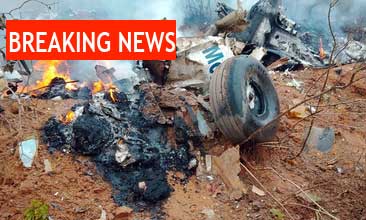Plane Crash in Kenya’s Kwale Region: 11 Fatalities, Investigation Underway
A devastating plane crash occurred in Kenya’s Kwale County, resulting in the deaths of 11 people, including 10 foreign tourists and a local pilot. The aircraft, operated by Mombasa Air Safari, was traveling from Diani to Kichwa Tembo airstrip near the Maasai Mara National Reserve when it went down in a forested, hilly area roughly 40 kilometers from the Diani airstrip.
Victims and Nationalities
The victims included ¹:
- 8 Hungarian nationals
- 2 German nationals
- 1 Kenyan pilot
Investigation and Possible Causes
The Kenya Civil Aviation Authority (KCAA) has launched an investigation into the crash. According to Kwale County Commissioner Stephen Orinde, the crash may have been caused by bad weather, with heavy rainfall and poor visibility reported in the area. The pilot lost communication with air traffic control shortly after takeoff, and the plane was discovered on fire after crashing in a rocky forested area ².
Rescue Efforts and Support
Local authorities and airline representatives have established support teams for families affected by the tragedy, providing counseling and assistance with logistics. Emergency responders have worked to recover remains from the scene of the crash and secure the area where debris and burnt wreckage were found.
Impact on Tourism and Aviation
The Maasai Mara National Reserve is a popular tourist destination, known for its wildlife and annual migration of wildebeest. This incident may raise concerns about safety and could impact Kenya’s tourism industry. The crash also highlights the need for more stringent regulation of the aviation industry in Kenya ².
Recent Aviation Incidents in Kenya
This incident comes two months after a medical aircraft crashed just outside of Nairobi, killing multiple people. Kenya’s aviation industry has faced challenges in the past, and recent audits have suggested improvements are needed in accident investigation and safety oversight.
International Response
Investigators have enlisted international experts, including those from the nationalities of the victims and the aircraft manufacturer, to assist in the investigation. The cause of the crash is still under review, and officials are working to determine the exact circumstances surrounding the tragedy.
As the investigation continues, the focus remains on providing support to the families of the victims and ensuring that measures are taken to prevent such incidents in the future.
Plane Crash Insurance Claim Guide
If you or your loved ones are involved in a plane crash, navigating the insurance claim process can be overwhelming. Here’s a step-by-step guide to help you through the process:
Understanding Aircraft Insurance Coverage
Aircraft insurance typically covers ¹:
- Aircraft Hull: Physical damage to the aircraft
- Spare Parts: Damage or loss of spare parts
- Legal Liability: Passenger compensation, third-party damages, and crew liability
Claim Process
- Notify the Insurer: Inform the insurance company as soon as possible after the accident.
- Gather Documents: Collect required documents, which may include:
- Certificate of Death: Or evidence of death from a government authority, aviation authority, or hospital official
- Claim Intimation Form: With bank details, such as NEFT mandate form, cancelled cheque, or bank account passbook
- Nominee/Beneficiary KYC Documents: Identification and proof of relationship
- Submit Claim: File the claim with the insurer, providing all required documents and information.
Compensation Calculation
Compensation for plane crash victims is typically calculated based on ¹:
- Montreal Convention 1999: Up to 128,821 Special Drawing Rights (SDRs) per passenger, approximately ₹1.54 crore (based on October 2024 exchange rates)
- Aircraft Insurance Policy: Coverage amount specified in the policy
Tips for Claimants
- Contact the Insurer: Reach out to the insurer’s emergency claims desk or customer service number
- Seek Professional Help: Consider consulting with an insurance expert or lawyer to ensure you receive fair compensation
- Keep Records: Document all correspondence and interactions with the insurer and other parties involved
Insurer Initiatives
Here are some specific tips for claiming insurance in the event of a plane crash:
General Tips
- Notify the airline and insurer: Inform the airline and your insurance company as soon as possible.
- Gather documentation: Collect:
- Flight itinerary and ticket receipts
- Insurance policy documents
- Identification documents (e.g., passport, driver’s license)
- Medical records (if injuries were sustained)
- Contact your emergency contact: Reach out to your designated emergency contact, if applicable.
Insurance Claims
- Life insurance: If a family member or loved one was on board, contact their life insurance provider to report the incident.
- Travel insurance: If you or a family member has travel insurance, contact the insurer to report the incident and initiate the claims process.
- Accident insurance: If the plane crash resulted in injuries or fatalities, contact your accident insurance provider.
Specific Documents to Collect
- Death certificate: Obtain a death certificate or proof of death from the authorities.
- Accident report: Get a copy of the official accident report from the airline or aviation authorities.
- Medical records: Collect medical records and bills related to any injuries.
Country-Specific Requirements
- USA: Contact the Transportation Security Administration (TSA) and the Federal Aviation Administration (FAA) to report the incident.
- UK: Contact the UK’s Air Accidents Investigation Branch (AAIB) and the airline’s insurers.
- Kenya: Contact the Kenya Civil Aviation Authority (KCAA) and the airline’s insurers.
- Canada: Contact the Transportation Safety Board of Canada (TSB) and the airline’s insurers.
Additional Tips
- Seek professional help: Consider consulting with a lawyer or insurance expert specializing in aviation insurance.
- Keep records: Organize and keep all documents and correspondence related to the claim.
These tips are general guidance and may not apply to every situation. It’s essential to review your specific policy and consult with your insurer or a professional if you have questions.
- Relaxed Documentation: Accepting alternative proof of death, such as government records or compensation paid by authorities
- Fast-Tracked Claims: Prioritizing claims for affected families
- Emergency Claims Desk: Establishing a dedicated desk for claimants
Additional Support
In some cases, additional support may be available, such as:
- Interim Compensation: Some airlines or organizations, like Tata Group, may offer interim compensation to affected families
- Counseling: Emotional support and counseling services may be provided to those affected by the crash
It’s essential to review your insurance policy and understand the claim process to ensure a smooth experience. If you’re unsure about any aspect of the process, don’t hesitate to reach out to the insurer or seek professional guidance.







